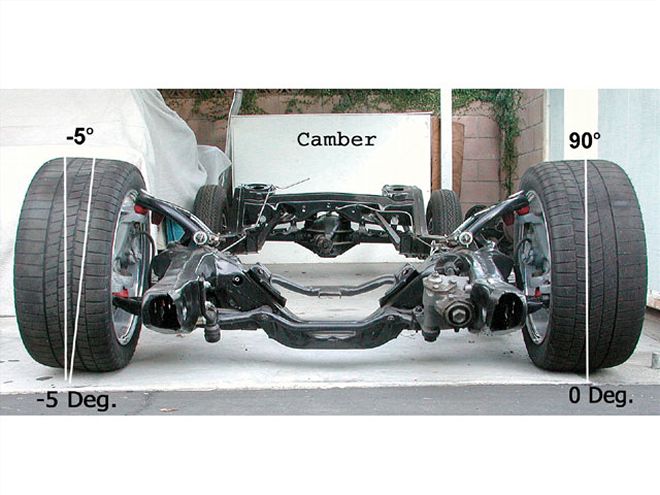

Let's face it, there's nothing glamorous about a wheel alignment. Yet proper alignment is critical to your car's performance whether you are on the dragstrip, road course, or tooling along the highway on your way to work. Caster, camber, and toe sound confusing, but as you will see, these are simple terms describing simple functions. We decided to take a look at the various types of alignments best suited to a variety of driving styles, and then we will walk you through the drag-race alignment we put on our very own project Barracuda.
The ExaminationBefore an alignment can be performed by a competent shop, a battery of tests and a thorough physical examination must be performed on your car. If your alignment shop doesn't go through these procedures, find another shop.
Once you have chosen a shop to handle your car's alignment, you should be prepared to divulge some information to the technician prior to getting started on the road-trip phase. It would be beneficial starting with a new set of front tires, but it is not required. You should be able to tell your alignment shop how many miles you got out of your last set of tires and how they wore. Since suspension components wear slowly, we tend to compensate for the gradual changes without realizing it. The testdrive can reveal lots of these ills. The technician should drive your car to look for any signs of alignment issues such as:
*Pulling to one side*Play in the steering wheel*Suspension noises*Soft feel*Steering-wheel position when the car is going straight
He should also examine the condition of the tires, looking for uneven wear (on used tires) and checking tire pressure.
The next item is ride height. If the car lists to one side, the weight is unevenly distributed. How does the front end sit in relation to the rear? Is it raked, sitting high, or level? Severe rake places more weight on the nose.
The rear alignment should also be checked for what is sometimes referred to as thrust angle, which occurs when the rearend does not sit squarely in the car. The rear tires must point straight ahead and sit straight up and down. If the rear alignment is off, it needs to be corrected before you can start on the frontend. Front alignment cannot compensate for thrust angle.
All of these points are critical to properly align a car for any type of application. Follow along as we put the tune on our frontend.
Alignment SettingsAccording to Jim Sleeper, owner of Sleeper Suspension Development, daily street-driven cars should have the camber on the driver side set at zero. The passenger side could benefit from 11/44 to 11/42 degree of negative camber. The caster should be split if one drives in mostly urban areas. Many states rely on the side of the road for drainage, so to compensate for this condition, more caster (up to 11/42 degree) can be dialed in to the driver side to compensate for road crown. The toe-in should be set to a total of 11/416 inch.
Drag-race cars will benefit most from as much positive caster as possible (see illustration) for high-speed stability. According to race-chassis-builder Jerry Bickel, the camber and toe-in should both be set to zero. Sleeper feels that toe-in should not exceed 11/416 inch on compression-when the front end is coming down after launch and when the car is under braking at the end of the track to promote stability.
A road-racing application also benefits from positive caster between 2 to 5 degrees depending on the car. The camber should generally be 1 to 2 degrees negative. Toe should usually be set at zero, but sometimes the tires will be toed out slightly to help the car with turn-in, but this is more of a driver's preference issue.
An autocross setup differs from a road-race tune in that the car sees very little high-speed straight-line driving and experiences more abrupt directional changes. Less caster is required on an autocrosser than a road racer for quick response without a lot of dive. The camber settings should be similar to those of the road-race car-approximately 1 to 2 degrees negative, and the toe should be set 11/416- to 11/48-inch out for quick turn-in response.
Performance Ride-Height SettingsWhen setting an alignment for a performance application, ride height is critical. Jim Sleeper of Sleeper Suspension Development (SSD) likes to align road-race cars based on the way they sit toward the end of the race. That is, he sets the alignment with the car carrying less than a quarter-tank of fuel. When the ride height is changed with a full tank, the weight distribution also changes. Sleeper likes his cars to get stronger at the end of the race, so he tunes their suspensions to take advantage of the reduction in fuel. Road racers and autocrossers alike work best with a lower center of gravity, which lowers the weight transfer from side to side. This will not upset the car and unload the tires. But if the car sits too low, it will tend to approach its limit and break loose abruptly.
In a drag application, Sleeper sets the alignment with the front end lifted two inches off of rest. This simulates the attitude of the car as it makes its way down the track. Afterwards, he sets the front back down to its resting position and measures toe. The car should exhibit a slight amount of toe-in. If it toes out, you have some serious suspension problems. When SSD sets a drag-racing alignment, he prefers to set the suspension higher in the rear than in the front to promote weight transfer. Also, the nose-down attitude keeps air from moving under the car on the big end of the track.